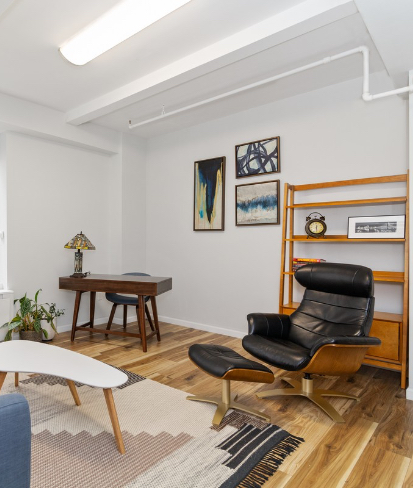Ever walked into a room and instantly felt at ease, as if the space itself was giving you a warm hug? That’s the magic of comfort-driven design, especially in a therapy office.
Now, imagine your clients stepping into a space that not only welcomes them but also helps melt away their stress and anxiety, making them feel safe and ready to share.
The way you design your therapy office can make all the difference in the world. We’ll show you how you can create a calming, client-centered environment that amplifies every session.
How Office Design Impacts Client Comfort in Therapy
The physical environment of a therapy office plays a critical role in how clients feel during their sessions. A well-designed space can help clients feel safe, relaxed, and more willing to engage in the therapeutic process.
Research shows that elements such as natural lighting, calming color schemes, and comfortable furniture can significantly reduce stress and anxiety levels.
When your clients enter a thoughtfully designed office, they are more likely to feel at ease, which can lead to more productive therapy sessions.
For more examples of how office design impacts client comfort, visit Our Spaces page.
Essential Design Elements for Comfort Design in Therapy Offices
To create a therapy office that prioritizes client comfort, consider incorporating the following design elements:
- Furniture: Choose comfortable and supportive furniture. Sofas and chairs should offer enough cushioning to allow clients to sit for extended periods without discomfort. Avoid overly stiff or formal seating arrangements, as these can create a barrier between the therapist and the client.
- Color Schemes: Use soothing colors such as soft blues, greens, or earth tones to create a calming atmosphere. Bright or bold colors can be stimulating and may increase anxiety. Neutral tones with a few carefully chosen accent colors can help create a balanced, serene environment.
- Lighting: Natural lighting is ideal for creating a warm and inviting space. Use soft, diffused lighting to avoid harsh shadows and glare if natural light is limited. Lamps and dimmable lights can help adjust the ambiance to suit different times of day and client preferences.
- Sensory Details: Incorporating sensory elements like soft textures, gentle background music, and calming scents can make your practice more comfortable. Consider using rugs, cushions, and throws to add warmth and softness to the space. Essential oils or diffusers with calming scents like lavender can create a more relaxing environment.
These elements are key to client-centered office design, which focuses on creating a space that meets clients’ emotional and psychological needs.
How a Comfortable Environment Improves the Therapeutic Experience
A comfortable therapy office can significantly improve the therapeutic experience by reducing barriers to communication and promoting a sense of safety. Your clients will feel at ease and be more open to fully engaging in the therapeutic process. Comfort-driven design also helps build trust, as clients see that their well-being is a priority.
Need more tips on creating a calm and welcoming environment? Check out our blog on Therapeutic Space Design.
Practical Tips for a Comfortable Therapy Room Setup
- Personalize the Space: Add personal touches that reflect your therapeutic style, such as artwork, plants, or books. These elements can make the space feel more inviting and less clinical.
- Optimize Layout: Arrange furniture to create a sense of openness and flow. Avoid clutter and ensure that clients have a clear path from the entrance to their seating area. A well-organized space can reduce stress and make clients feel more comfortable.
- Use Technology Wisely: If you use technology in your sessions, ensure it is integrated seamlessly into the design. Keep cables and devices tidy and out of sight when not in use to maintain a peaceful environment.
- Maintain Cleanliness: A clean, well-maintained office is essential for client comfort. Regularly clean and sanitize surfaces, especially in high-traffic areas, to create a safe and welcoming space.
Create Spaces That Promote Healing and Growth
Designing a therapy office with client comfort in mind is important if you want to create a positive therapeutic environment that supports your clients’ mental and emotional well-being.
Ready to transform your therapy office into a calming haven?
Visit Therapeutic Alliance Suites to explore our thoughtfully designed spaces, or contact us to learn more about how we can help you create the perfect environment for your clients.
